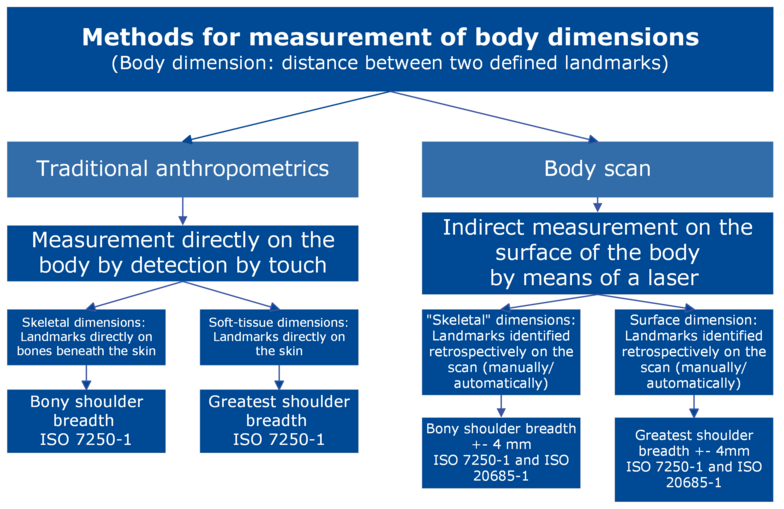The body dimensions should always be measured by means of a defined method on defined landmarks in defined standard positions adopted by the test subjects. The test subjects generally wear only light clothing during performance of the measurements.
The measurements are based upon defined landmarks or reference planes such as the floor or sitting surface. For length, depth and breadth measurements, two defined landmarks1 yield a measurement path. The distance from the floor to the vertex for example yields the body height.
In traditional anthropometrics, the landmarks can be seen or felt directly on the human body. They can be divided into two groups:
Skeletal landmarks require defined bone points under the skin to be detected by touch, for example on the elbow, knee or shoulder.
Landmarks on the surface of the body are detected directly on the skin (soft tissue dimensions). Examples are measurement of the width across the thighs with the test subject sitting (body breadth sitting), or the greatest, i.e. bideltoid shoulder breadth.
During a laser body scan, only the surface of the body is scanned. The dimensions are then estimated indirectly by automatic or manual determining of the landmarks by means of a cursor on the resulting surface scans.
The landmarks and thus the dimensions obtained by different methods are not always directly comparable; this is the case for example for the bony (bi)acromial shoulder breadth. Whereas in the conventional method, the skeletal landmarks of the shoulder are felt and the direct distance from one skeletal point to the other is measured, the body scan describes only the surface of the shoulder. Incorrect positioning of the landmark on the scan may therefore result in higher values for the scanned data.
The standards concerned describe the landmarks for conventional anthropometrics (EN ISO 7250-1) and body scanning (EN ISO 15536-1), and the scope for transfer of the dimensions, i.e. their compatibility. For breadth dimensions for example, a permissible deviation/measurement tolerance of + 4 mm is stated.
The feature particular to anthropometric data is a result of the method by which they are obtained, since anthropometric dimensions:
- Are almost always measured with the person being measured in a standardized baseline position. In reality, people rarely assume this baseline position for longer periods. For example, the height sitting (the height of the body above the seat surface, i.e. the trunk length + head height) is measured with the test subject seated and the upper body stretched. Data are also stated for a relaxed, comfortable body posture (see Handbuch der Ergonomie); this is however the exception, since the data measured in this way are not readily comparable, and their reproducibility presents problems. These data are nevertheless useful for practical purposes (see Comfortable body posture)
- In most cases, they are dimensions that are measured in fixed (static) positions. They rarely reflect movement processes, which – depending upon the dynamics – may have a major influence (see Movement)
- They relate to the human body when for the most part unclothed. In most applications however, human beings are clothed. The clothing may reduce dimensions – such as the waist girth when very tight trousers are worn – or increase it to different degrees (depending upon the type of clothing), as for example the increase in the foot dimensions caused by shoes or in the circumferential dimensions caused by thick jackets (see Clothing)
- They cannot always be combined freely, since they are not the dimensions of a specific individual, but values for a studied group (percentiles, see What are percentiles?). A person with a body height corresponding to the 5th percentile does not necessarily also have the leg length of the 5th percentile; it must be assumed that their other body dimensions may lie in quite different percentile ranges. In other words: where a person's body height corresponds to the 5th percentile, their other body dimensions will not all also be equal to the respective 5th percentiles (see also Summation of body dimensions)
- They vary between groups of people of different geographical origin (populations); this must be taken into account during application of the data (see Influence of the geographical origin)
- They are sex-specific, since women have on average not only lower length dimensions than men, but also different proportions. At a given body height for example, men generally have the longer legs (see Influence of the sex)
- They reflect height, length, breadth and circumferential dimensions of the human body. These may be skeletal dimensions or may be measured directly on the surface of the body (soft tissue dimensions) (see How are body dimensions measured?)
- They should have been measured by means of internationally standardized methods (such as EN ISO 7250-1) with the use of suitable instruments (see How are body dimensions measured?)
- In accordance with conventional anthropometrics, measurement is performed in direct contact with the human body. In the indirect measurement method of scanning (see How are body dimensions measured?), the human body surface is measured without contact
- They can also be changed by contact with the body's immediate environment or by pressure upon soft tissue. The height sitting for example is reduced when the body sinks into an upholstered seat surface (see Contact environment)
1 further information on individual landmarks can be found in the glossary
To top
